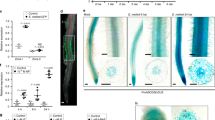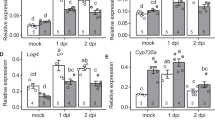Abstract
Induced development of a new plant organ in response to rhizobia is the most prominent manifestation of legume root-nodule symbiosis with nitrogen-fixing bacteria. Here we show that the complex root-nodule organogenic programme can be genetically deregulated to trigger de novo nodule formation in the absence of rhizobia or exogenous rhizobial signals. In an ethylmethane sulphonate-induced snf1 (spontaneous nodule formation) mutant of Lotus japonicus, a single amino-acid replacement in a Ca2+/calmodulin-dependent protein kinase (CCaMK) is sufficient to turn fully differentiated root cortical cells into meristematic founder cells of root nodule primordia. These spontaneous nodules are genuine nodules with an ontogeny similar to that of rhizobial-induced root nodules, corroborating previous physiological studies1. Using two receptor-deficient genetic backgrounds we provide evidence for a developmentally integrated spontaneous nodulation process that is independent of lipochitin–oligosaccharide signal perception and oscillations in Ca2+ second messenger levels. Our results reveal a key regulatory position of CCaMK upstream of all components required for cell-cycle activation, and a phenotypically divergent series of mutant alleles demonstrates positive and negative regulation of the process.
This is a preview of subscription content, access via your institution
Access options
Subscribe to this journal
Receive 51 print issues and online access
$199.00 per year
only $3.90 per issue
Buy this article
- Purchase on Springer Link
- Instant access to full article PDF
Prices may be subject to local taxes which are calculated during checkout




Similar content being viewed by others
References
Tirichine, L., James, E. K., Sandal, N. & Stougaard, J. Spontaneous root nodule formation in the model legume Lotus japonicus: A novel class of mutants nodulates in absence of Rhizobium. Mol. Plant Microbe Interact. 19, 373–382 (2006)
Radutoiu, S. et al. Plant recognition of symbiotic bacteria requires two LysM receptor-like kinases. Nature 425, 585–592 (2003)
Krusell, L. et al. Shoot control of root development and nodulation is mediated by a receptor-like kinase. Nature 420, 422–426 (2002)
Patil, S., Takezawa, D. & Poovaiah, B. W. Chimeric plant calcium/calmodulin-dependent protein kinase gene with a neural visinin-like calcium-binding domain. Proc. Natl Acad. Sci. USA 92, 4897–4901 (1995)
Liu, Z., Xia, M. & Poovaiah, B. W. Chimeric calcium/calmodulin-dependent protein kinase in tobacco: differential regulation by calmodulin isoforms. Plant Mol. Biol. 38, 889–897 (1998)
Levy, J. et al. A putative Ca2+ and calmodulin-dependent protein kinase required for bacterial and fungal symbioses. Science 303, 1361–1364 (2004)
Mitra, R. M. et al. A Ca2+/calmodulin-dependent protein kinase required for symbiotic nodule development: Gene identification by transcript-based cloning. Proc. Natl Acad. Sci. USA 101, 4701–4705 (2004)
Schauser, L. et al. Symbiotic mutants deficient in nodule establishment identified after T-DNA transformation of Lotus japonicus. Mol. Gen. Genet. 259, 414–423 (1998)
Senoo, K. et al. Isolation of two different phenotypes of mycorrhizal mutants in the model legume plant Lotus japonicus after EMS-treatment. Plant Cell Physiol. 41, 726–732 (2000)
Kawaguchi, M. et al. Root, root hair, and symbiotic mutants of the model legume Lotus japonicus. Mol. Plant Microbe Interact. 15, 17–26 (2002)
Schenk, P. W. & Snaar-Jagalska, B. E. Signal perception and transduction: The role of protein kinases. Biochim. Biophys. Acta 1449, 1–24 (1999)
Takezawa, D., Ramachandiran, S., Paranjape, V. & Poovaiah, B. W. Dual regulation of a chimeric plant serine/threonine kinase by calcium and calcium/calmodulin. J. Biol. Chem. 271, 8126–8132 (1996)
Sathyanarayanan, P. V., Cremo, C. R. & Poovaiah, B. W. Plant chimeric Ca2+/calmodulin-dependent protein kinase. Role of the neural visinin-like domain in regulating autophosphorylation and calmodulin affinity. J. Biol. Chem. 275, 30417–30422 (2000)
Sathyanarayanan, P. V., Siems, W. F., Jones, J. P. & Poovaiah, B. W. Calcium-stimulated autophosphorylation site of plant chimeric calcium/calmodulin-dependent protein kinase. J. Biol. Chem. 276, 32940–32947 (2001)
Sathyanarayanan, P. V. & Poovaiah, B. W. Autophosphorylation-dependent inactivation of plant chimeric calcium/calmodulin-dependent protein kinase. Eur. J. Biochem. 269, 2457–2463 (2002)
Gleason, C. et al. Nodulation independent of rhizobia induced by a calcium-activated kinase lacking autoinhibition. Nature doi:10.1038/nature04812 (this issue)
Rathjen, J. P., Chang, J. H., Staskawicz, B. J. & Michelmore, R. W. Constitutively active Pto induces a Prf-dependent hypersensitive response in the absence of avrPto. EMBO J. 18, 3232–3240 (1999)
Perry, J. A. et al. TILLING reverse genetics tool and a web-accessible collection of mutants of the legume Lotus japonicus. Plant Physiol. 131, 866–871 (2003)
Acknowledgements
We thank Finn Pedersen for plant care and crossing.
Author information
Authors and Affiliations
Corresponding author
Ethics declarations
Competing interests
The sequences for the L. japonicus ecotype GIFU CCaMK gene and mRNA are deposited in the EMBL nucleotide database under accession numbers AM230792 and AM230793. Reprints and permissions information is available at npg.nature.com/reprintsandpermissions. The authors declare no competing financial interests.
Supplementary information
Supplementary Figure 1
Calcium oscillations in root hairs in response to purified Nod factor. (PPT 294 kb)
Supplementary Figure 2
In vitro culture of wild type and snf1-1 mutant tissues. (PPT 33607 kb)
Supplementary Figure 3
Alignment of chimeric Ca2+/calmodulin dependent protein kinases from Lotus, Medicago, pea, tobacco, lily, rice and Physcomitrella. (RTF 165 kb)
Supplementary Figure 4
The log-log plot corresponding to figure 4e. (PPT 47 kb)
Supplementary Methods
This file contains a detailed Methods section. (DOC 30 kb)
Supplementary Table 1
Summary of loss of function ccamk mutations and gain of function snf1 mutations. (DOC 24 kb)
Supplementary Table 2
This file shows complementation of ccamk-2 in the presence of Mesorhizobium loti; transformation of ccamk-2 in the absence of Mesorhizobium loti; and transformation of snf1-1 in the absence of Mesorhizobium loti. (DOC 41 kb)
Rights and permissions
About this article
Cite this article
Tirichine, L., Imaizumi-Anraku, H., Yoshida, S. et al. Deregulation of a Ca2+/calmodulin-dependent kinase leads to spontaneous nodule development. Nature 441, 1153–1156 (2006). https://doi.org/10.1038/nature04862
Received:
Accepted:
Issue Date:
DOI: https://doi.org/10.1038/nature04862
This article is cited by
-
Molecular Approaches to Improve Legume Salt Stress Tolerance
Plant Molecular Biology Reporter (2024)
-
An emerging role of heterotrimeric G-proteins in nodulation and nitrogen sensing
Planta (2023)
-
Exploring a rhizobium to fix nitrogen in non-leguminous plants by using a tumor-formation root pathogen
Phytopathology Research (2022)
-
Nutrient regulation of lipochitooligosaccharide recognition in plants via NSP1 and NSP2
Nature Communications (2022)
-
Nod factor perception: an integrative view of molecular communication during legume symbiosis
Plant Molecular Biology (2022)
Comments
By submitting a comment you agree to abide by our Terms and Community Guidelines. If you find something abusive or that does not comply with our terms or guidelines please flag it as inappropriate.



